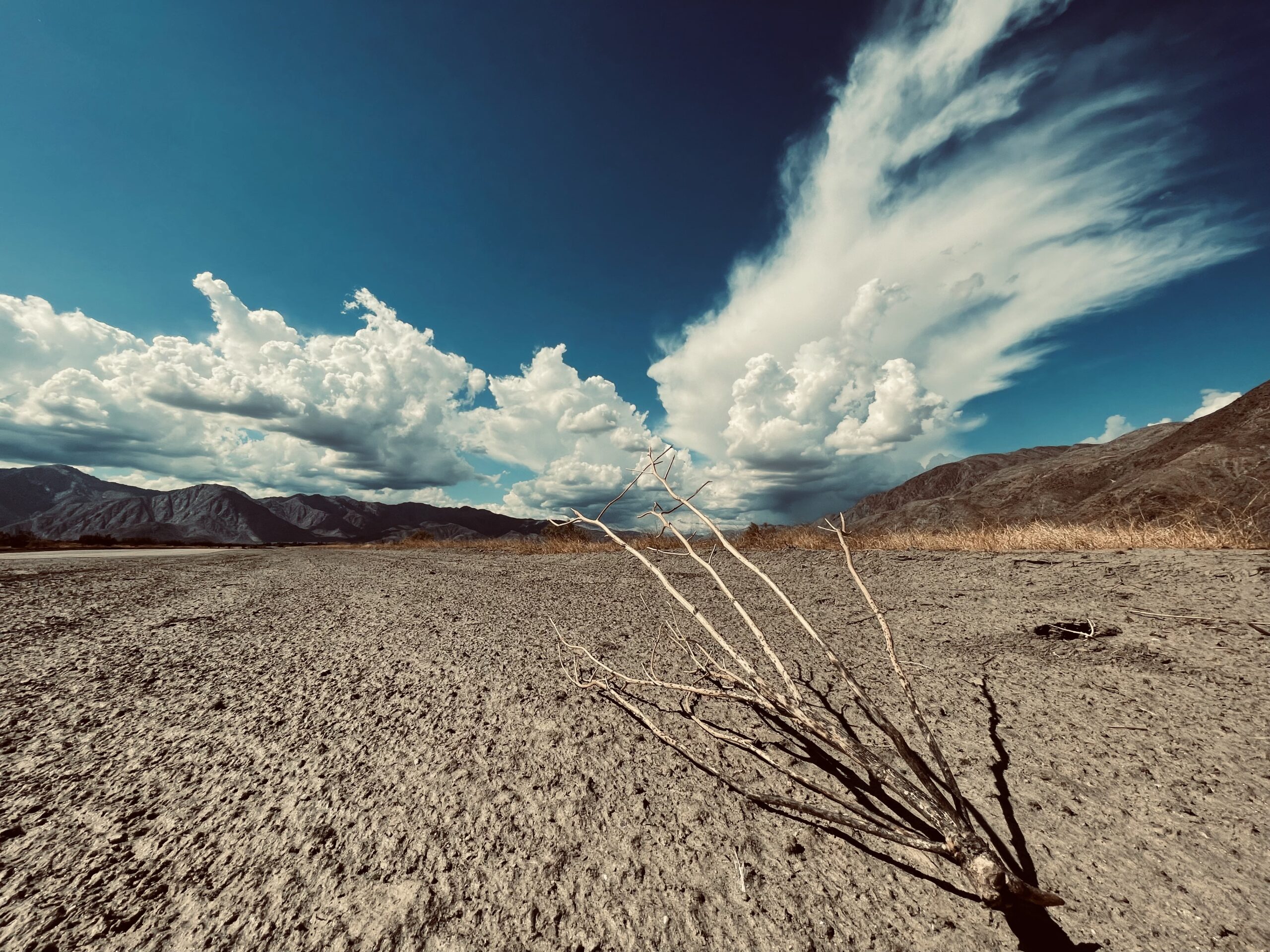
The days are markedly shorter, the nights cooler, and our winter gear can soon make its way into our wardrobes for daily use. Our plants are in transition too, breathing a sigh of relief after those brutal heat waves last summer. Native plants literally spring to new life with the first rains, and fall weather signals them to open their little doors and windows for winter moisture to come in.
Current events, history, review, and notes
According to our California natural garden calendar of seasons, we are still in Fall, at the beginning of our horticultural year.
Fall – October, November – rains commence, many garden tasks, fall flowers.
Winter – December, January – rain, short cool days, calming dormancy, winter flowers.
Spring – February, March, April – more rain, birds, butterflies, life abounds, abundant flowers.
Pre-Summer – May – farewell cool and moist, hello hot and dry, transition month, preparations.
Summer – June, July, August – judicious watering, long hot days, seeds, summer blooms.
Post-Summer – September – farewell hot and dry, hello cool and moist, transition month.

Watering
Unless a significant rain event is in the forecast as you read these lines, you might want to perform a Deep Soak irrigation on your entire garden… get a little jump on the season. Refreshing Sprinkles can still be useful, especially at the end of a hot afternoon, but they are not really necessary, as the plants are not stressed (like in summer) and the cool nights offer relief. All the same, these simple acts of providing living water to plants are healthy for both parties, you and your garden.
Note: Be wary of dry Santa Ana winds that often come in November and stress the plants. Watch weather forecasts and water ahead, or do Refreshing Sprinkles in the afternoon during windy periods.
Related to Watering
Not familiar with the terms Deep Soak and Refreshing Sprinkle? For a complete definition of the Deep Soak plus Refreshing Sprinkles method (DS + RS) see the section “Watering” here: https://californianativeplants.com/blog/august-in-the-natural-garden-2024/
With a little luck, we can put our sprinkler systems, mini sprinklers, and hand watering tools into their dormant state for the entire winter. If we get regularly spaced, significant rain events this season, our DS + RS protocols will not be needed again until around May 2025.
Pruning
November is a good month to do any and all pruning. Thinning, heading back, shaping, and grooming should be done now, to prepare for a flush of new growth next spring. Note: manzanitas generally require no heading back, and the shrub forms can be improved only by thinning and opening up their crowns “so a bird can flit around inside.” If you do trim the branch ends (head back) you may be removing the nascent flower buds (sometimes not even visible yet), thereby preventing the plant from blooming January – March. Be careful.
Remember to sanitize your tools with an 8-second dip in 10% bleach solution or alcohol, or use Lysol spray.
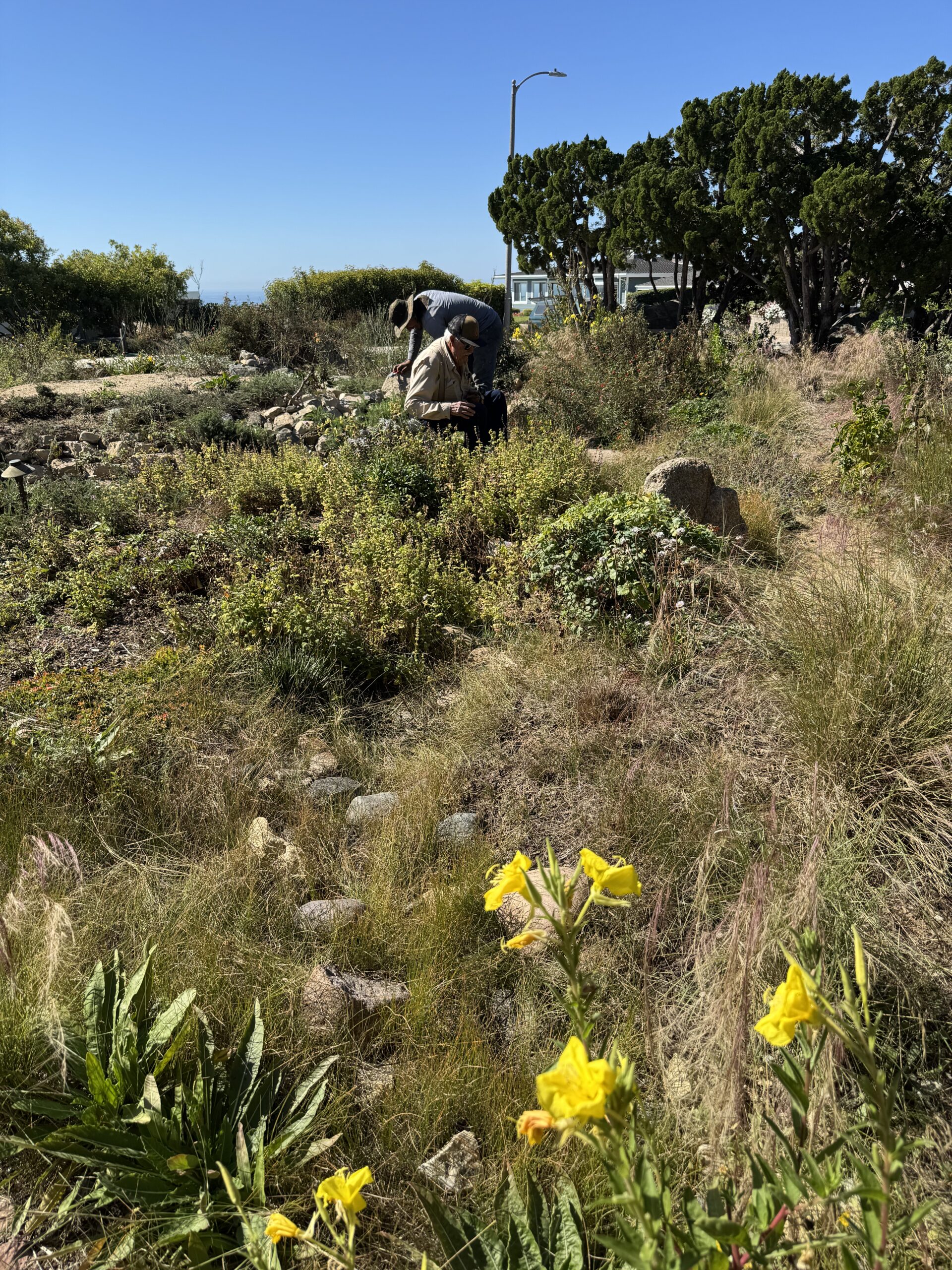
Weeding
Let’s assume you are caught up on this. If not, this is a good time to do a major clean-up and overhaul; thinning, pruning, removing weeds, fertilizing and mulching (if needed), then a proper Deep Soak, before the rains get here (we hope!)
Mulching / Top Dress
If your soil is bare, and your plants are not at a stage where they are creating their own topdress through leaf drop, and a mulch fits into your garden narrative, this is a good time to apply. Always choose a fresh, natural, organic wood product (not green waste unless composted properly), a chunky bark product is preferable. If your garden needs a mineral topdress to effectively tell its story, a fresh application of DG or rock aggregate, 1” thick, will be your choice. If you have room, and your garden is planted in thematic sections, be sure to use different topdress materials in different areas to tell a complete and unique Re-wild story.
Feeding
A direct quote from last month’s newsletter:
Yes. All purpose organic, granular (dry) fertilizer scattered about and scratched into the top 1/2” of soil. I’m guessing many readers do not apply fertilizers to their natural garden, and I guess that’s also fine. However, native plants need love too, and besides, the activity is healthy for you, the gardener as well. So give it a try, ideally just prior to a forecasted rain. You will be pleased and so will your plants.
Troubleshooting – Varmints, Pests and Diseases
Again, directly quoting October 2023 newsletter:
Yes. Ants, mainly. By applying a growth hormone bait you can knock the colony back, but unfortunately probably not eradicate Argentine ants from the garden. These little devils have no redeeming quality to my knowledge. (To all my Argentine friends, no offense intended… this is simply the accepted common name for Linepithema humile.) They displace our native ant species wherever they thrive. Argentine ants sabotage our gardens by tending injurious plant pests then they feed on the excretions (honeydew) made by the aphids, scale, mealybug, etc.
Annual Wildflowers
The trick is to perfectly time seed sowing with the approach of winter rains. If October slipped by without much activity in your garden, now is the time to do that major clean-up, and feeding, which would also include sowing wildflower seeds. Come on over! We have several custom mixes available. Also, this year we have an abundance of native bulbs (which require a little more effort than seeds to plant), so come get them while they last. Seed and bulbs are available through our website or by calling for mail order.
Adding New Plants
We are still at the start of the perfect season to plant native plants, and our nursery is full of plants just for you.
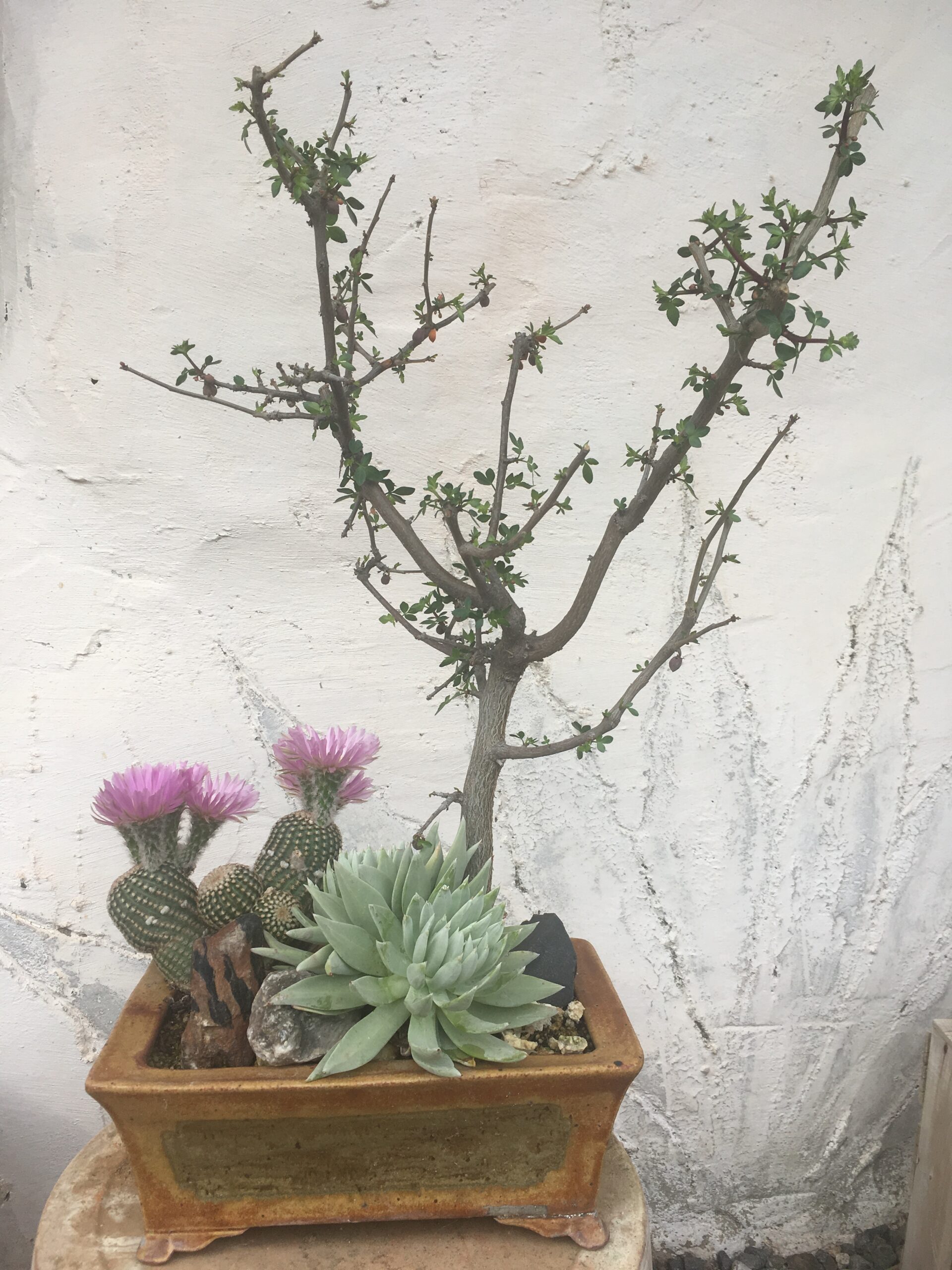
My Patio Re-wild
In this new section of our monthly blog we will discuss container gardening. You can bring nature home, even in the smallest of outdoor spaces, by growing natives in pots. This can lead to a productive and enjoyable hobby: choosing attractive pottery, potting mix, plants, rocks, sticks, and top dress to create miniature ecosystems right outside your door. Caring for these little jewels will be satisfying and healing for all involved. And for sure as you create habitat in miniature, you will see pollinators and other garden beneficials visiting regularly, but probably no grizzlies or wolves… they need more room.

Stay tuned as we announce special activities. We’ll keep all the materials and a potting bench ready for you to use every day and we’ll facilitate training as necessary. You can consistently plan on taking home a few finished “My Patio Re-wild” pots every time you visit.
Oh and did I mention that these little beauties will make great Christmas gifts?
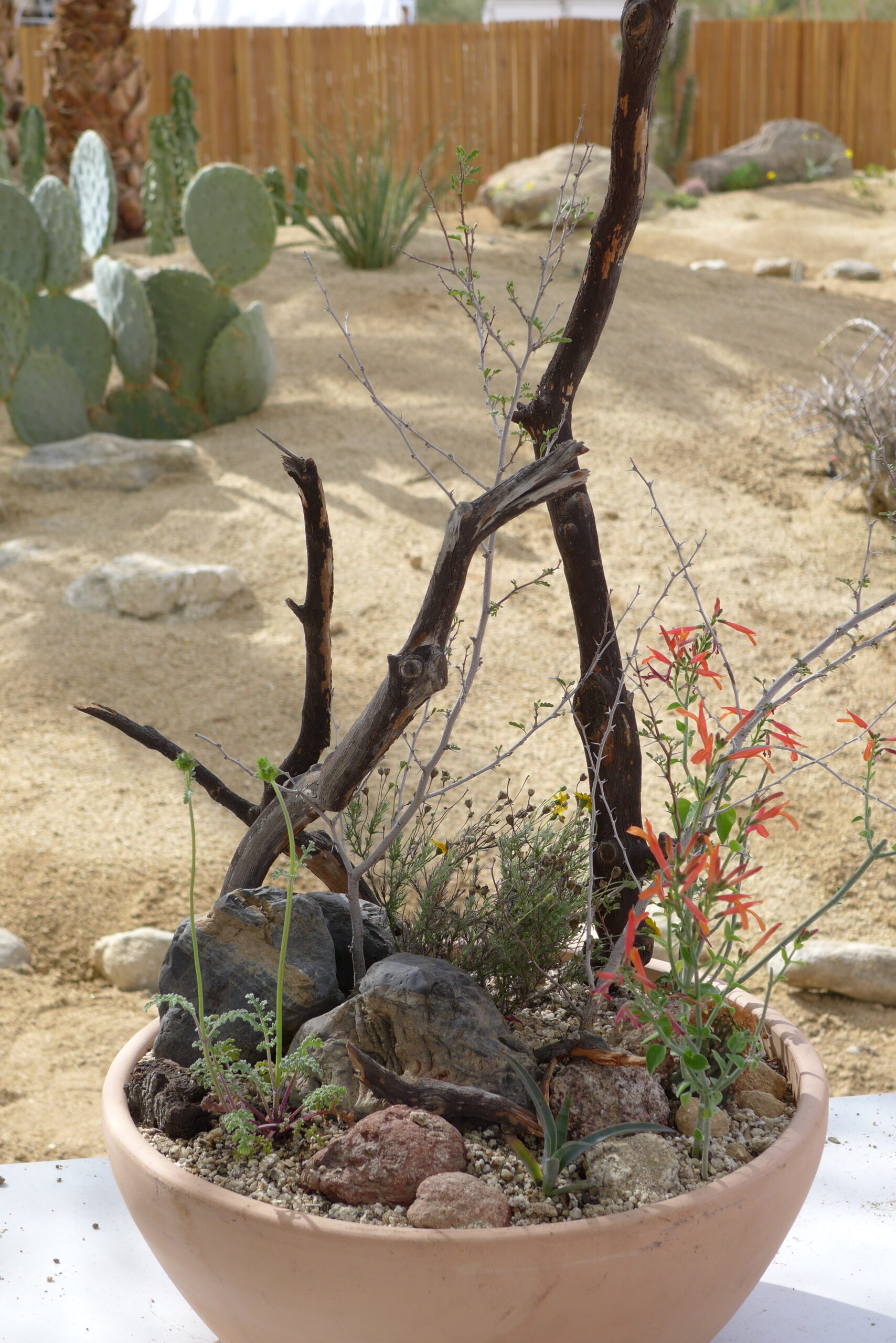
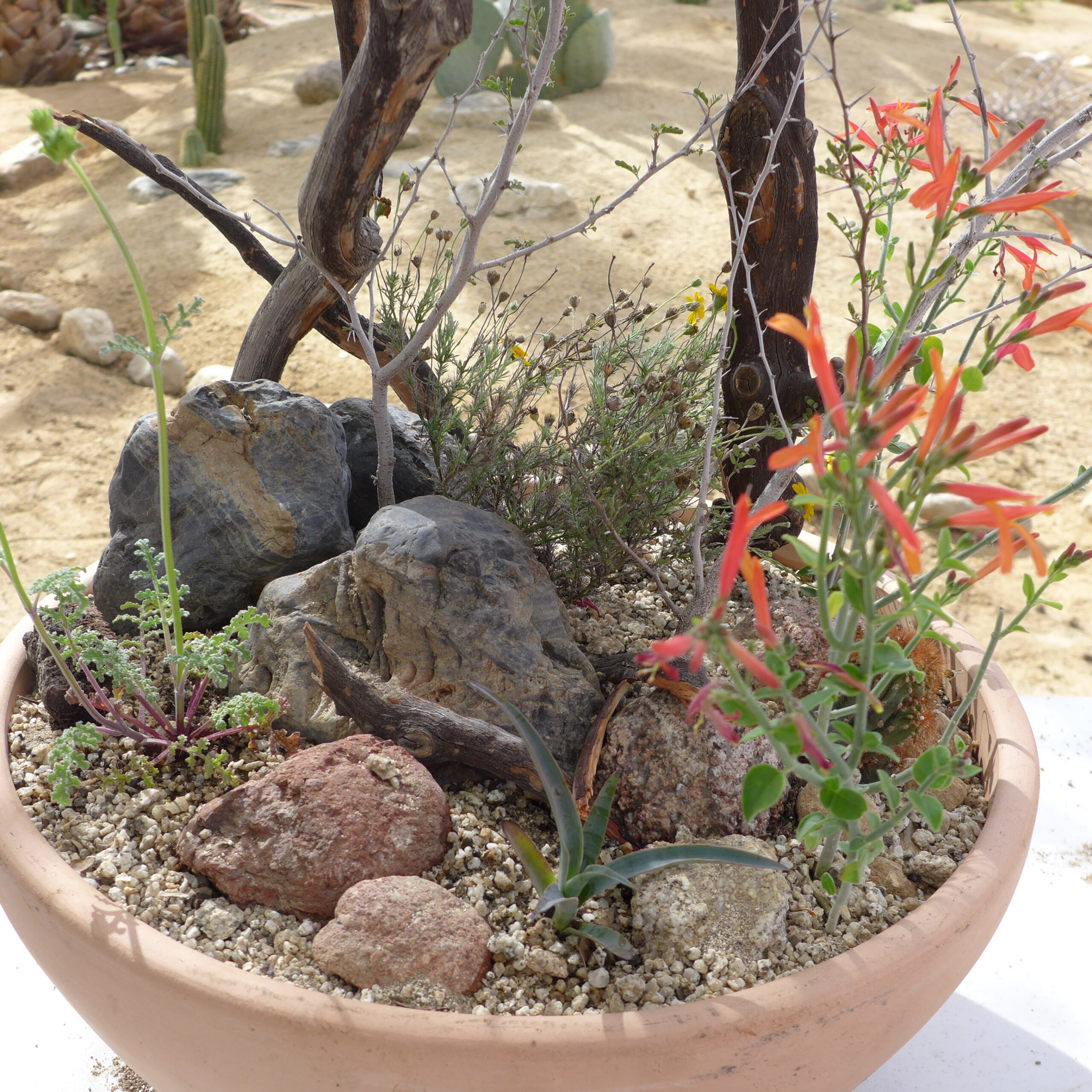
Phytophilia
Our love of plants and their love for us. When I look and listen over a natural landscape or into a natural garden, this month I hear the words, “We are still here!” In the human-built environment, exotic plants and artificial amenities tend to overpower the still small voice of natives, but not in our minds. We still hear them, and know how to hone in on the smallest natural garden, even if it’s surrounded by non-native plants dominating an exotic landscape that provides habitat only for rats, gophers and snails. And when we find a natural garden in the midst of that mess, we recognize it as a welcome respite, a jewel, an oasis of life, like finding a spring in a dry place.
Once inside our natural garden, the plants continue, “We are still here.” Meanwhile, on our forays into truly natural areas we can obtain wellness and inspiration to better create and care for our natural gardens. And out there in the wilderness, we hear plants clearly saying, “We are all that is still here!” and that’s a message (reminder) we need to hear as often as possible.
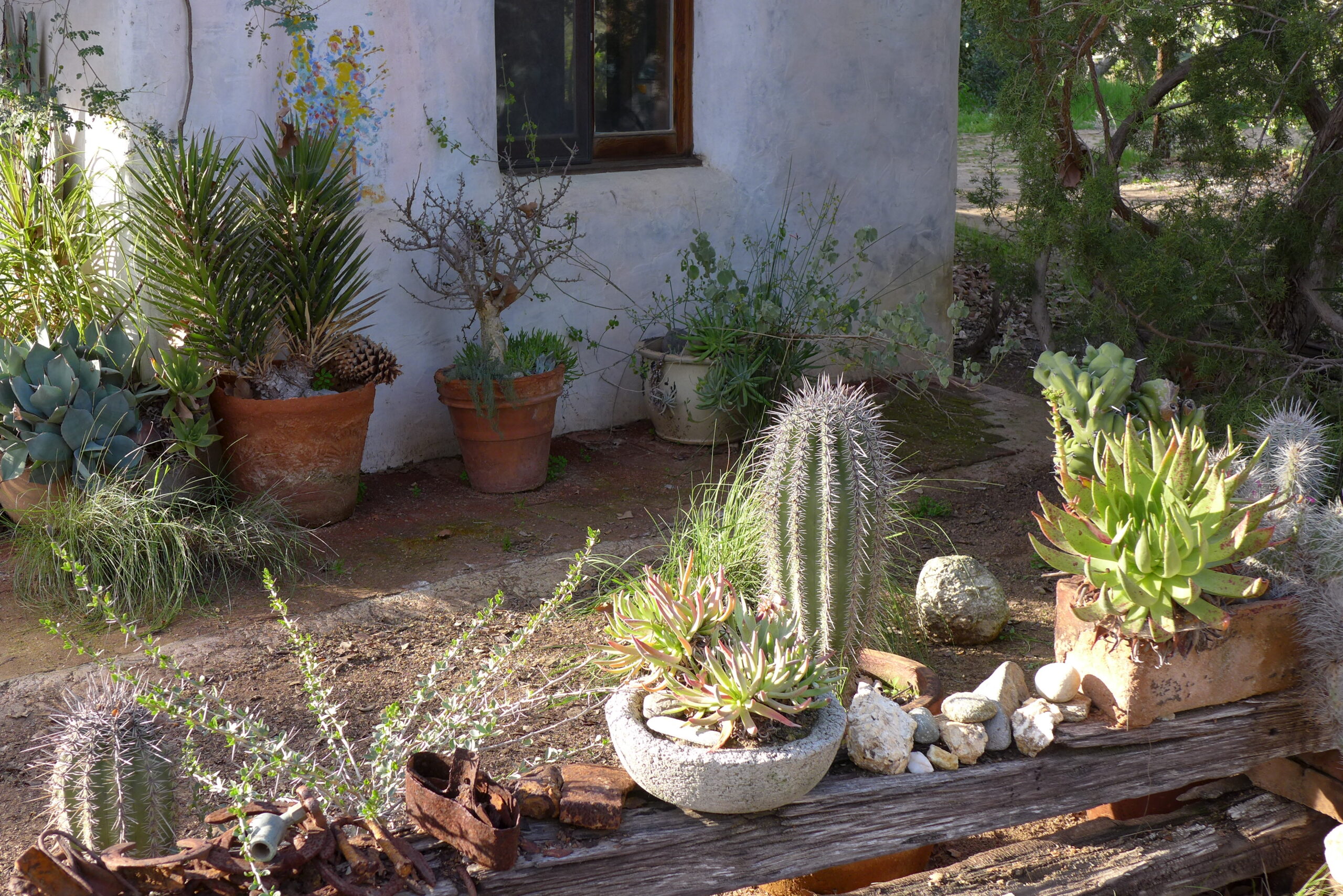
Re-wild
Sow seed – the plants will germinate however and whenever they may, and surprise you in their placement.
Plant bulbs – available now in great quantities, this is the season, only available now.
Plant natives – no-brainer, the very definition for Re-wild.
Study maps – as if the land becomes alive at your fingertips.
Read about nature – longer nights, shorter days, a fireplace, we get it.
Take nature pictures – the winter light is perfect.
Journal – it will be fun to look back next November to see how you were feeling in this one.
Garden ahead – think about winter and spring in everything you do.
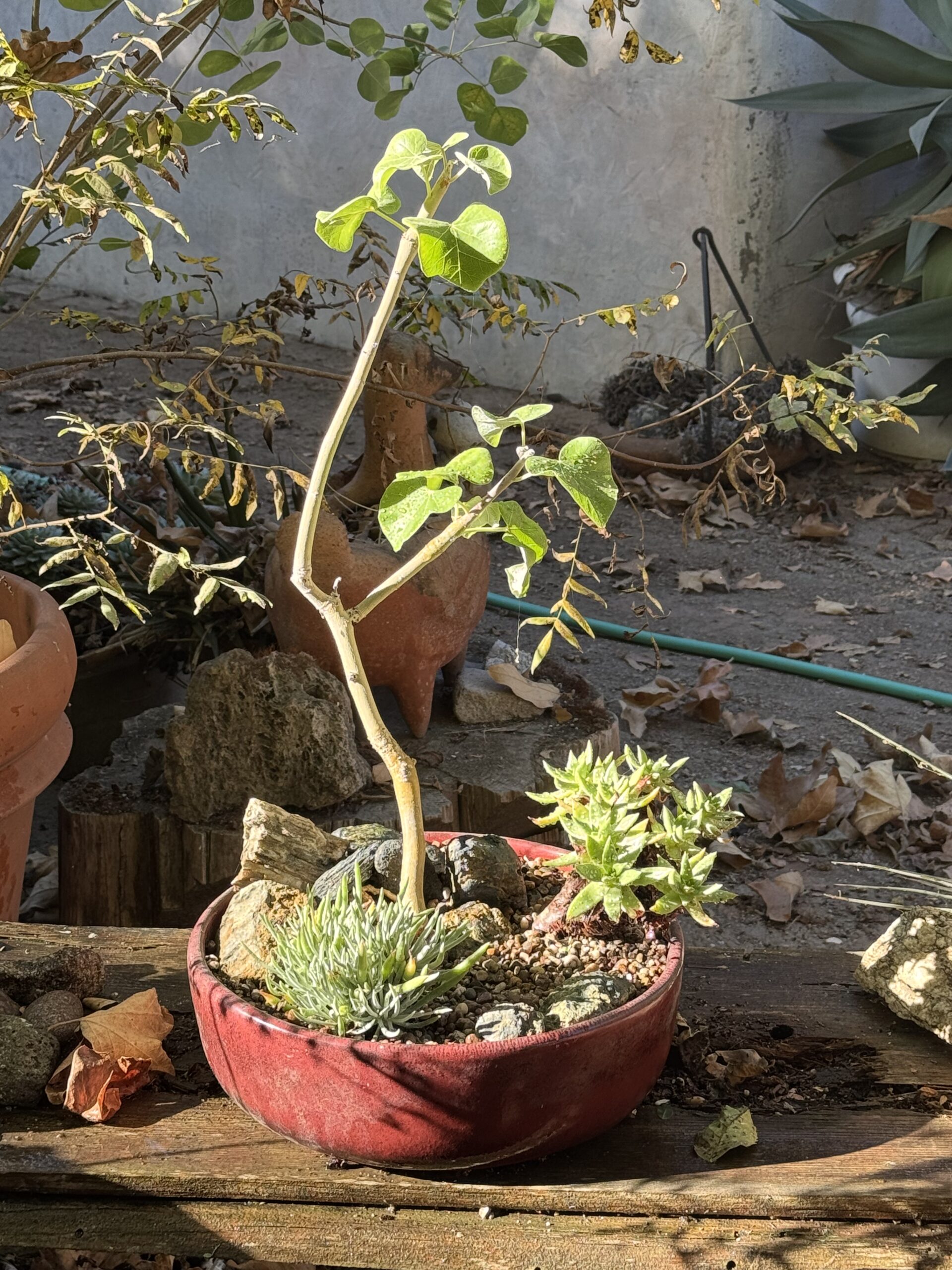
A little Baja gem. Lomboy (Jatropha cinerea), Dudleya attenuata ssp. orcuttii, D. candelabrum, a shallow pot of desert color, a good potting medium, meaningful rocks, and an appropriate top dress.
Important Review
Fall is for planting
The last DS + RS before the first rain
All manner of pruning OK
Keep. Weeds. Out.
If mulch, yes now.
Organic fertilizer, perfect in Oct / Nov
Trouble. Shoot ants and other varmints on sight.
Plant seed and bulbs now. Perfect month.
Add new plants now. Perfect month.
Mini-ecosystems, nature pots, My Patio Re-wild.
We are still here, now go see us where we are all that is still here.
November, an active month for Re-wild.
Engage
Tracing my finger over the contour lines of a topo map, slowly, I imagine the country. Would this canyon be choked with vegetation, and impassable? Would this hill be too steep? Did the ancients ever walk this route?
The days are shorter. My fires last longer because they start earlier. The sun’s low position proves the shadows and light stunningly beautiful all day. The cold rains have yet to arrive, so the time is perfect for wild walks in any terrain, coastal, foothill, grassland, chaparral, woodland, forest, mountain, and desert.

When I was a kid, I played a little baseball. I was better in the field than at bat. Very enthusiastic, but a little intimidated at gametime, I held my own, but there were better players. When my dad would take me to see the pros, it would be literally a “Big League” game, where I could witness first hand the real thing, as good as it gets, the best… this is how it is done right.
In making natural gardens, we do the best we can with what we’ve got. But to see how it’s really done right, the real thing, the very best, we need to go watch a Big League game. As natural gardeners, our trips into natural areas are for learning, and for me, fall has always been the best time. Maybe it’s the clear air, the brisk temperatures, the vegetation in transition, or the stillness. Or the relief I feel after summer. Maybe it’s the long evenings back home or at camp, making notes on my map. It reminds me of those games with my dad, and the kid in me still inspired to field and bat like a pro.
Last week Hilda and I were at the Grand Canyon. Big League stuff. We stayed on the south rim, with no hiking or backcountry treks, only huge views of Nature’s World Series. Back home, I am finding time to study the lineups… the literal king of all topo maps, the guidebooks, and the natural history of the place. Oh and by the way, we took a circuitous route home to avoid pure freeway driving, and we learned a little more about this land that we love.
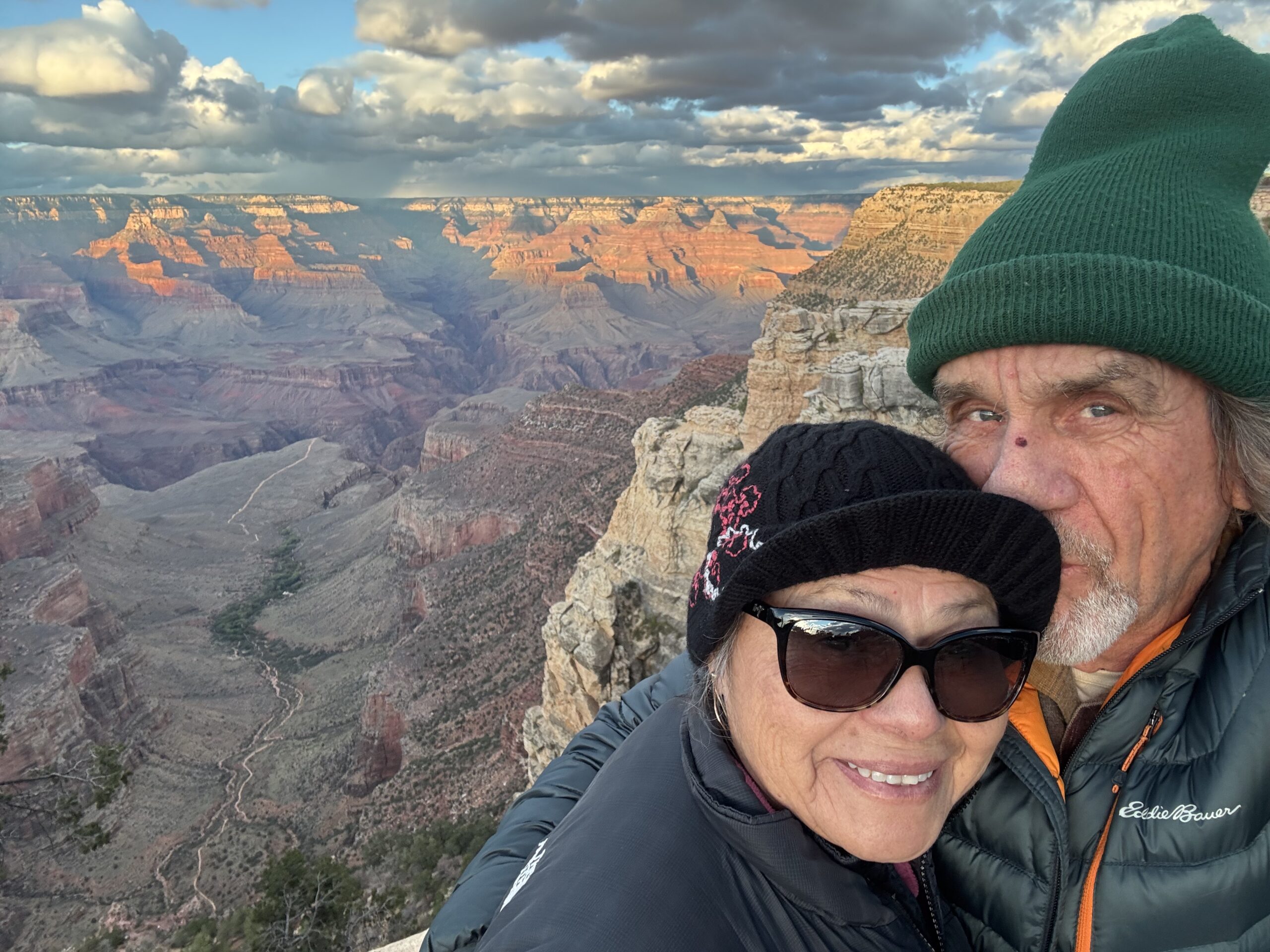
Slow down. Take in the whole game. Always choose the lonely road and the crooked trail, even if only in your mind by tracing your finger on a map. And always put all your acquired inspiration, knowledge, skill, and newfound technique to good use. Try to play like a pro.
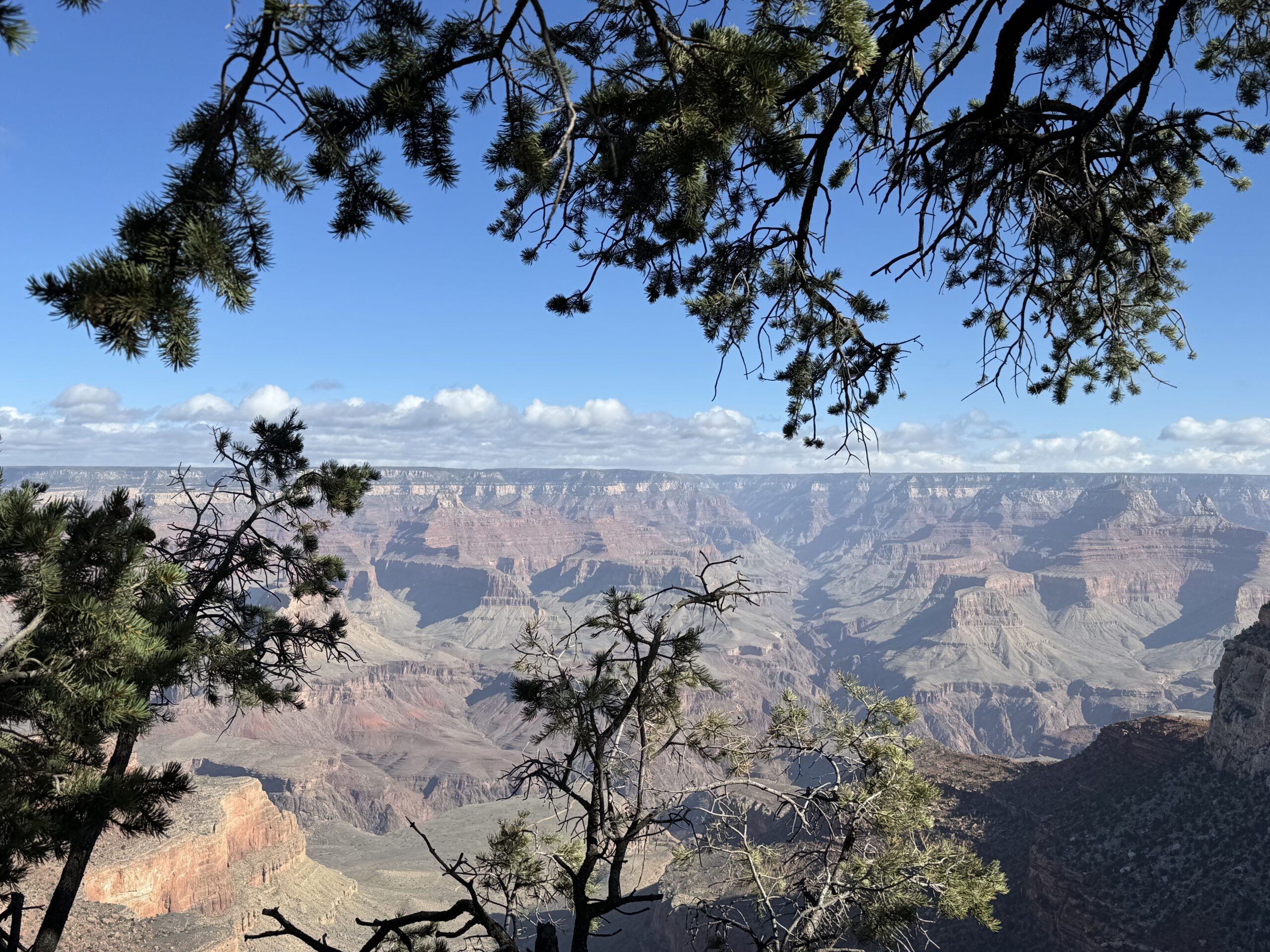
“It seems a gigantic statement for even nature to make all in one mighty stone word, apprehended at once like a burst of light, celestial color its natural vesture, coming in glory to mind and heart as to a home prepared for it from the very beginning. Wildness so godful, cosmic, primeval, bestows a new sense of earth’s beauty and size. Not even from the high mountains does the world seem so wide, so like a star in glory of light on its way through the heavens.” John Muir
Let’s keep makin’ it and makin’ it over and over again.
From NOVEMBER in the Natural Garden,
Mike Evans
All photos by Mike Evans unless otherwise noted. Text by Mike Evans
Questions? Help is just one call or one email away. Call (949) 728-0685 or email (with pictures if you like) our special helpline: gardenhelp@californianativeplants.com